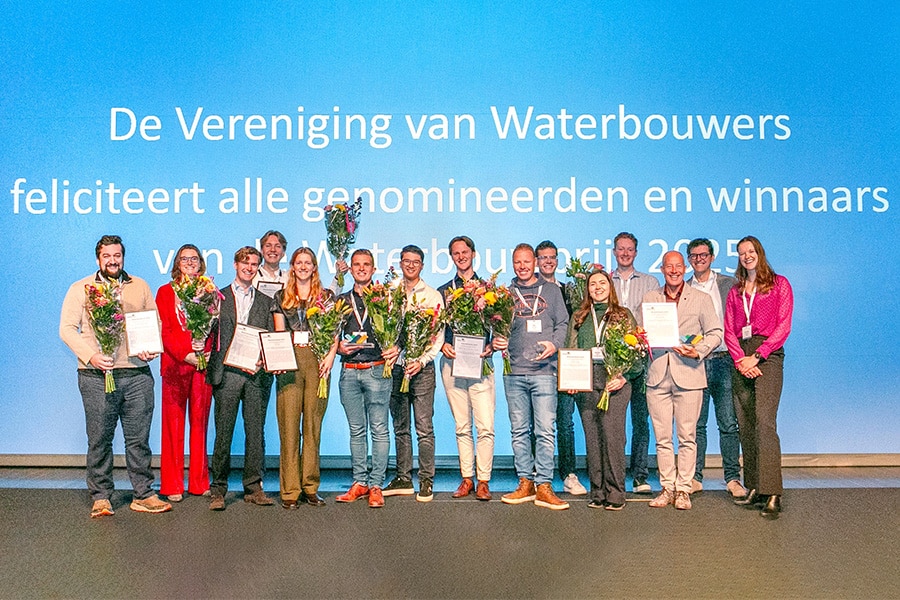
"The infrastructure sector in the Netherlands is innovative, we support that as a government"
These are uncertain times for everyone right now. Fortunately, despite the corona pandemic, the earth, road and water construction industry is not sitting still. Or should we say is not standing still? Because besides the fact that the innovation that so characterizes our sector is taking place unabated, there is also a lot to do. That work did not fall out of the sky; we as a sector owe a large part of it to our government's thinking along and, above all, thinking ahead.
GWW Magazine had the honor of interviewing Cora van Nieuwenhuizen, Minister of Infrastructure and Public Works, about the government's involvement in the patriotic infrastructure sector, with themes such as the current crisis, the role of the Netherlands as a European transit port, digitalization within the infra and sustainability.
The infrastructure sector in times of crisis
Previous editions have featured articles from across the GWW industry expressing gratitude for all the projects that have been pulled forward by the government, with the understanding that concerns were also expressed. Concerns about the order book when this pandemic is officially over. Will all the powder be shot by then? Not only have maintenance and replacement projects been brought forward, their implementation was faster than normal, thanks to less traffic on the country's roads. In what way is the government ensuring continuity? Minister van Nieuwenhuizen: "Of course, bringing projects forward did not start because of the corona pandemic. The sector was in danger of getting into trouble earlier because of the nitrogen and PFAS issues. In order to avoid a crisis in the sector at that time by postponing new construction projects, we worked with all our might to bring forward maintenance and replacement projects. Before that, there was extensive consultation with the construction industry. Then there was the corona pandemic with all its consequences. Keeping the sector working then became even more important. We then sat down with all the industry associations to form a task force. The conclusion was: we can continue to work while respecting the corona measures. We can work at a distance of one and a half meters, we can work safely by paying attention to each other. Thus, within the task force, we determined the right methodology that was needed to perform work under the changed conditions."

As much as 1.9 billion for accelerated maintenance and replacement
After World War II, much infrastructure was rebuilt within the same time frame. "The projects of that time are all eligible for maintenance and replacement. In total, the government set aside 1.9 billion euros for this, of which we are now bringing 1.1 billion to the market on an accelerated basis. This is in addition to the 265 million euros we had already allocated for this," the minister said. Examples she cited include major maintenance on the A50 and the N18, major dredging work and replacing classic lighting with LED lighting. "A budget of 44 million euros has been set aside for the replacement of lighting," she explained. "Furthermore, you can think of projects such as replacing bollards and replacing guide rails. You could say some of the projects could have waited, but we decided to do it anyway because it can be done well outside the nitrogen and PFAS issues. A lot of work surrounds these types of projects, they are multidisciplinary."
Leading by example as a government
"The infrastructure sector in the Netherlands is innovative, we absolutely support that as the central government," Minister van Nieuwenhuizen continued. "By offering our support for innovation, it pays for the market to invest in it. We therefore like to set a good example. Consider, for example, the theme of electrification. For example, we provide subsidies for making driving and sailing vehicles greener. We are happy to cooperate in making asphalt more sustainable; we also see great innovations taking place in that area. The 'demonstration garden' in the A73 is a nice example, where we are looking at life extension, noise reduction, reduced rolling resistance and better recycling of asphalt. If you look at DBFM contracts, you understand that adjusting now will yield a lot of benefits later."
New construction projects
We ask the minister if it is known when the new construction projects will come back into the picture. The minister replies, "When I started, we had the problem of underutilization. More money than projects... We started to adjust that by actually pulling projects forward. The new construction projects that have been delayed because of the nitrogen and PFAS situation will come up again after this phase of accelerated maintenance and replacement projects. What we learned from the previous crisis is that the BBL (vocational training) pathways dried up. Not enough young recruits were coming into the sector, even though the projects were picking up. Then you have a shortage of workers. Therein lies an important focus point for the sector, if it wants to be able to work at full war strength soon."
Minister van Nieuwenhuizen went on to explain that the central government is not the whole market and while work has been brought forward from the central government, there has been less anticipation at the provincial and municipal levels. "To do our bit there, we have allocated an additional €500 million over a 10-year period for road safety. The idea is that local projects will come about on a co-financing basis with the province. There has been a lot of interest, so much so that we have increased the 100 million euros allocated for 2020/2021 to 200 million. In November it will be announced which projects will be honored. Pure profit for road safety and the regional GWW sector. Many small projects together make a big job!"
The Netherlands as a major transit port
When it comes to the Netherlands as a major transit port for goods, the government is adopting the "corridor idea. Minister van Nieuwenhuizen explains: "We like to facilitate the route to Belgium, France and Germany. There is a lot of contact about that, within our country and with the countries concerned. We have a good road infrastructure, we have truck parking facilities. We are betting on our waterways and railroads. Everything is being done to handle more. Frans Timmermans is making the case for the "green deal," there is a lot of consultation about what we can do together and how we can become more sustainable. There is a subsidy stream from the EU, under the name "Connecting Europe. Among other things, the promotion of shore power facilities stems from that. A green light is being given for freight transport, especially in these corona times, which is hugely important. As European transport ministers we are pulling together well together in this story."
This cooperation is evident, among other things, in the new port vision that has been created. "We have expressed the intention not to compete with each other, but rather to strengthen each other.
For example, the Minister of North Rhine Westphalia declared that Rotterdam is their gateway, rather than Hamburg. Then consider that North Rhine Westphalia itself has as many inhabitants as the whole of the Netherlands. In the Benelux context, initiatives have been taken to introduce digital bills of lading, another great example."

Digitization within the infra
When asked where the government comes into the picture, when it comes to the digitization transition within the sector, the answer is, "We are trying to do a lot ourselves as a government, but we cannot do without the business community. That is why we have jointly set up a 'Data Taskforce' with eight countries. This task force also includes six car brands and eight navigation system manufacturers. When it comes to road safety, you should not compete, but cooperate. Making road traffic 'connected' at the level of the vehicle itself creates a smart network from which everyone benefits. For example, consider a warning of slipperiness -linked to GPS data- that goes into the network when a car detects a wheel slipping. Has an airbag deployed? Then the car reports an accident to the network. Rear-ending traffic is alerted super fast, as is Road Management. This all falls under the heading of "Incident Management," and developments in this are of paramount importance. The cooperation of all major car manufacturers means that this system will soon become a reality."
Who are all on this Data Taskforce? "They are the following EU Member States and Road Authorities: The Netherlands, Ministry of Infrastructure and Water Management, Spain, Ministry of Home Affairs La Subdirección General de Gestión de la Movilidad DGT, Finland, Transport and Communications Agency TRAFICOM, Germany, Federal Ministry of Transport and Digital Infrastructure, Luxembourg, Ministry of the Economy, Austria, ASFINAG, Belgium, Flanders MOW and England, Highways England," the minister lists. "The participating Service Providers are: HERE Europe B.V. and TomTom Traffic B.V. and as Automotive Supplier: NIRA Dynamics. The participating automotive brands are: Audi, BMW AG, Ford Smart Mobility Ltd, Mercedes Benz, Volvo Cars, Scania and Honda. Furthermore, the association ACEA."
Sustainability in infra
What is the government doing to promote sustainability in the sector and support the climate agreement? "We are starting a subsidy scheme for emission-free equipment. We are doing pilot projects, for example on the A16. We will give increasing weight to zero-emission work in our tendering procedures, so that there is a reason for the market to move in that direction. I understand that this can sometimes be very difficult for companies, but on the whole it also generates work. We distinguish between the construction phase and the use phase when it comes to sustainability. An additional advantage is that emission-free work in infra is a catalyst for non-infra projects, because emission-free work is desirable everywhere. After all, many tools are interchangeable and are also used in the construction industry. And anyone wondering if it is feasible to electrify in terms of equipment: all the major car brands are already doing it, the manufacturers of large equipment have already had their first successes. It can be done and it is coming. The market determines what happens namely," Minister van Nieuwenhuizen concludes.

![[Vacancy] Civil Advisor at Spaarnelanden 4](https://gww-bouw.nl/wp-content/uploads/2025/12/Naamloos-2-kopie.jpg)


